Inequalities containing variables in an exponent in mathematics are called exponential inequalities. The simplest example of such inequalities are inequalities of a type of a^x> b or a^x
Instruction
1. Define a type of inequality. After that use the corresponding method of the decision. Let inequality of a^f (x)> b where a> 0, a≠1 be given. Pay attention to value of parameters an and b. If a> 1, b> 0, then the decision is all values x from an interval (log[a](b); + ∞). If a> 0 and a<1, b> 0, then x ∈ (-∞; log[a](b)). And if a> 0, b <0, then x is accepted by any valid value. For example, 2^x> 3, a=2> 1, b=3> 0, then x ∈ (log[2](3); + ∞).
2. Pay attention in the same way to values of parameters for inequality of a^f (x) <b. At a> 1, b> 0 x accepts values from an interval (-∞; log[a](b)). If a> 0 and a<1, b> 0, then x ∈ (log[a](b); + ∞). Inequality has no decision if a> 0 and b <0. For example, 2^x <3. Here a=2> 1, b=3> 0, then x ∈ (-∞; log[2](3)).
3. Solve inequality of f (x)> g(x) if the exponential inequality of a^f (x) is given> a^g(x) and a> 1. And if for this inequality a> 0 and a <1, then solve equivalent inequality of f (x) <g (x). For example, 2^x> 8. Here a=2> 1, f (x) =x, g(x)=3. That is all x> 3 will be the decision.
4. Prologarifmiruyte both parts of inequality of a^f (x)> b^g(x) on the basis of an or b, considering properties of an exponential function and a logarithm. Then if a> 1, then solve inequality of f (x)> g(x) ×log[a] (b). And if a> 0 and a <1, then find a solution of inequality of f (x) <g(x) ×log[a] (b). For example, let inequality 2^x> 3^(x-1), a=2> 1 is given. Prologarifmiruyte both parts on the basis 2: log[2] (2^x)> log[2] (3^(x-1)). Use the main properties of a logarithm. It turns out, x> (x-1) ×log [2](3), and the solution of inequality will be x> log[2](3)/(log[2](3)-1).
5. Solve an exponential inequality by method of replacement of a variable. For example, let inequality 4^x+2> 3×2^x is given. Make replacement of t=2^x. Then inequality of t^2+2> 3×t turns out, and it is equivalent to t^2−3×t+2> 0. Solution of this inequality t> 1, t <2. Return to an initial variable: x^2> 1 and x^2<2 или x^2> 2^0 and x^2 <2^1. Apply a method from a step 3. The interval will be the solution of an exponential inequality 4^x+2> 3×2^x (0; 1).

